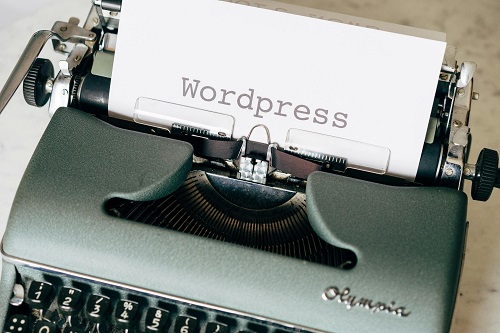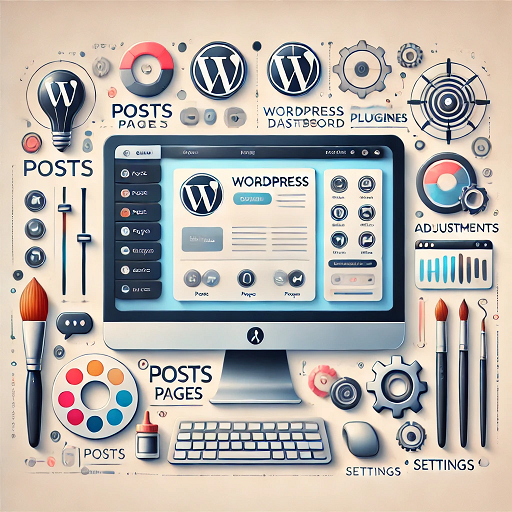
The WordPress Dashboard is your command center for managing your website. It provides all the tools you need to create, edit, and maintain your site in one accessible location. Understanding how to navigate the WordPress Dashboard effectively is crucial for maximizing your productivity and ensuring that your website runs smoothly. This section will provide an overview of the Dashboard’s main features, how to customize it to your liking, and tips for efficiently managing your site.

Overview of the WordPress Dashboard
Use the URL yourdomain.com/wp-admin to access the Admin area of your WordPress website. After entering your username and password, you’ll be greeted by the Dashboard, which is organized into several key areas:
- Admin Bar: Located at the top of the screen, the Admin Bar provides quick access to essential features. From here, you can manage your site, view updates, create new posts, and access your profile. The Admin Bar also allows you to switch between different sites if you’re managing multiple WordPress installations.
- Welcome Panel: The Welcome Panel, displayed on the right side of the Dashboard, offers quick links to help you get started. You can access options like creating a new post, adding media, and customizing your site. You can close this panel if you find it distracting, but it can be a helpful resource for beginners.
- Main Menu: The left sidebar features the main menu, which provides access to all the core functionalities of your WordPress site. This menu includes links to Posts, Pages, Media, Comments, Appearance, Plugins, Users, Tools, and Settings. Hovering over each menu item reveals submenus with additional options.
- At a Glance: The At a Glance section, located in the main Dashboard area, provides an overview of your site’s current status. You’ll see the number of published posts, pages, and comments, as well as information about your WordPress version and theme.
- Activity: The Activity section shows your recent posts and comments. It also reminds you of any pending comments that require approval. This feature helps you stay on top of your site’s interactions and keeps your content fresh.
- Quick Draft: The Quick Draft box allows you to jot down ideas for new posts quickly. You can save your drafts without fully committing to a new post, making it easier to organize your thoughts.
Key Features of the WordPress Dashboard
Understanding the key features of the Dashboard will help you manage your site effectively:
- Posts: This section allows you to create and manage blog posts. You can add new posts, edit existing ones, and organize your posts into categories and tags. You’ll also find options to manage post formats, add media, and schedule posts for future publication.
- Pages: Similar to posts, the Pages section enables you to create and manage static pages such as About, Contact, and Services. Unlike posts, pages are typically used for content that is less time-sensitive and provides information about your site.
- Media: The Media Library is where all your uploaded images, videos, and documents are stored. You can upload new media files, organize them into folders, and edit image details like titles, captions, and alt text for SEO purposes.
- Comments: This section lets you manage user comments on your posts. You can approve, reply to, or delete comments, helping you foster engagement with your audience. You can also manage spam comments using the Akismet plugin or similar solutions.
- Appearance: The Appearance menu allows you to customize your site’s look and feel. You can select a theme, customize your theme settings, manage widgets, and create menus. Understanding how to use these features will enable you to create a visually appealing and user-friendly site.
- Plugins: This section is crucial for extending the functionality of your WordPress site. You can install, activate, deactivate, and delete plugins here. Plugins add features like SEO optimization, security enhancements, and social media integration.
- Users: The Users section allows you to manage the people who have access to your site. You can add new users, assign roles (Administrator, Editor, Author, Contributor, Subscriber), and edit existing user profiles.
- Settings: The Settings menu is where you can configure various aspects of your site, including general settings, writing, reading, discussion, media, and permalinks. These settings impact how your site operates and how content is displayed.
Customizing the Dashboard

One of the advantages of WordPress is its flexibility. You can customize your Dashboard to suit your workflow:
- Screen Options: Located in the upper right corner of the Dashboard, the Screen Options button allows you to control which elements are displayed on your screen. You can choose to show or hide various widgets, making it easier to focus on the information that matters most to you.
- Dashboard Widgets: You can also rearrange the widgets on your Dashboard by dragging and dropping them to your preferred locations. This customization helps you prioritize the information you want to see at a glance.
- Add or Remove Widgets: If you want additional functionality, consider adding custom widgets from plugins. Conversely, you can remove or minimize widgets that you find unnecessary or distracting.
Tips for Efficiently Managing Your Site
To make the most out of the WordPress Dashboard and manage your site effectively, consider the following tips:
- Regular Updates: Keep your WordPress core, themes, and plugins updated to ensure optimal performance and security. The Dashboard will notify you of available updates, and it’s essential to apply them promptly.
- Backups: Regularly back up your website to prevent data loss. You can use plugins like UpdraftPlus or BackupBuddy to automate this process. Backups are crucial for recovery in case of website crashes or other issues.
- User Roles and Permissions: If you have a team working on your website, assign appropriate user roles based on their responsibilities. This practice helps maintain security and control over your site’s content.
- Explore Settings: Take the time to explore the Settings menu thoroughly. Familiarizing yourself with these settings can enhance your site’s performance and improve the user experience.
- Engage with Your Audience: Use the Comments section to engage with your audience. Responding to comments and feedback can help build a community around your content and enhance user loyalty.
- Utilize Help Resources: If you encounter issues or need assistance, the WordPress community is vast and supportive. You can access forums, tutorials, and documentation on the official WordPress site or find helpful resources on platforms like YouTube.
You will quickly learn how to navigate the WordPress dashboard. It is an essential skill for anyone looking to manage a WordPress site effectively. Understanding the key features, customizing the interface to suit your workflow, and implementing best practices will streamline your site management process. As you become more familiar with the Dashboard, you’ll be better equipped to create, update, and maintain your website, ultimately enhancing your online presence and achieving your digital goals.